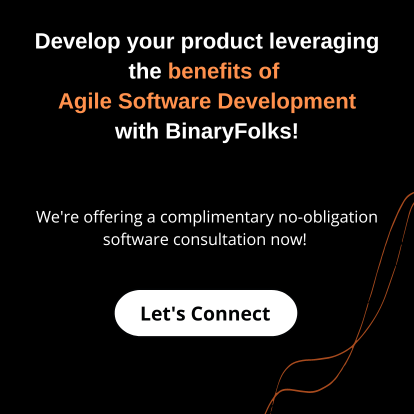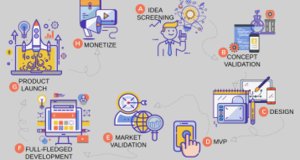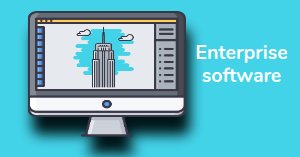
Understanding the benefits of Agile software development is essentially divided into two stages - the first stage demands a basic understanding of Agile’s competitive development methods and how Agile manages to one-up them. Second, is understanding how Agile works in favor of the individuals involved in the development cycle, be it a stakeholder or a developer. This blog will be an overall guide discussing all of these points and more in detail.
Software development is a nimble industry, and with the introduction of AI, the time required for a new tech to become an industry staple is only shrinking. In this market state, if your business is still stuck with the traditional development methods that need a grand planning session before even laying the rudimentary foundations of the project, then it’s high time you switch. That being said, just the fact that you’re here clearly indicates that you’re already thinking in the right direction and just need someone with a little more experience in this topic to back your intuition. Well, we will gladly take on that responsibility!
According to a report, a whopping 71% of organizations were using Agile methodologies in their software development cycle in 2023 (Businesswire, 2023). That means almost 3/4th of the organizations developing software solutions worldwide already have the ability to get a new functionality onboard in the fastest way possible. Surely it rings a bell of urgency in your head right now! While it might be too late to procrastinate beyond this point, the good thing is that you can still get an advantage against the 71% of companies using the right approach towards integrating the Agile method. But before we talk about how to implement it the right way, let’s take a step back and start from the basics.
Talk to Our Software Development Experts!
Agile Development Method - The Concept
Conceptually, Agile is a modern take on traditional software development methods and is focused on getting the product out in the market as quickly as possible while keeping clients and stakeholders in the loop for further improvements.
Here, the project is broken down into “sprints”, which are simply a smaller version of “milestones” used in a traditional development cycle. These sprints last for a few weeks and at the end of each sprint, the product being developed must have visible and user-verifiable changes. This post-sprint version is then sent to the clients to test and provide their feedback, confirming what parts of the sprint they are satisfied with, and what parts could be better.
Although it may seem like a laborious task for the clients, in reality, Agile-friendly tools like JIRA, Trello, and Asana make the collaboration between the software development team and the clients seamless and hassle-free. Compared to the traditional development methods where clients only had the opportunity to test the product after the entire coding phase was completed, the introduction of Agile was a major improvement. Let’s expand on this and analyze how Agile compares to the other popular development methodologies in the next section.
How does Agile Software Development Compare to Other Traditional Methods?
Although Agile is clearly the industry favorite, other methodologies are still practiced to some extent across the entire software development landscape. Let’s discuss them briefly and see how they compare to Agile -

[1] Waterfall Vs Agile
Waterfall was probably the most popular development method before the agile revolution and is what we currently address as the “traditional development method”. In Waterfall, the project is typically broken down into 6 major phases - ideation, designing, coding, testing, deployment, and maintenance. The software development firm has to stick to the details defined in the ideation stage till the very end. Once a BRD is signed, the project is locked. Any new requirements/features that were either missed or newly introduced after finalizing the BRD have to wait for months or years (in some cases) to be implemented again. And this second cycle again needs an entire tedious cycle of its own. Which is not just frustrating for the clients but also places the company at a competitive disadvantage.
We’ve already established the fact that the current software development market is extremely nimble with technologies and features going from relevant to industry standards to obsolete within months. So, by the time a certain enhancement was introduced using Waterfall, it either became obsolete or the opportunity to gain a competitive advantage from the feature was completely lost.
This is where Agile’s sprint-based development comes into play. It not only allows a business to get the new functionalities on their software while it's still new and relevant, but it also gives the stakeholders enough legroom to make changes to the project goals in case they find an alternative idea that suits their business needs more after the project kick-off.

[2] Lean Vs Agile
The primary agenda of Lean’s implementation is to make sure that the product is delivered to the customers faster, while focusing on the core functionalities first, without adding unnecessary or optional quality-of-life features.
While Agile follows a similar concept when it comes to addressing customer needs, it differentiates itself from Lean with its more structured and organized operational layout. It allows a loop-based approach that is focused on working on the changing needs of the customer based on market shifts.
Think of it this way, if you’re building a house for an individual using Lean and Agile, you would quickly set up a room with a bed, table, cupboard, and AC using both methods. Now as time passes, let’s say the individual got married and had kids. Firstly, he has to make enhancements to his room and then set up another room for the kids.
With Agile these changes can be easily implemented. However, with Lean, you will be stuck with the initial room layout, until and unless you decide to make a new solution from scratch with the updated requirements.

[3] RAD Vs Agile
Rapid Application Development (RAD) can be considered as a transitional method between Waterfall and Agile, as it draws similarities from both methods. Firstly, like Waterfall, RAD also requires a closed scope of deliverables that need to be defined at the beginning of a development cycle. With that in hand, RAD aims to deploy a prototype or an MVP of the solution as quickly as possible to get the initial feedback from the customers.
Once the initial prototype is approved, the development is continued across multiple iterations with feedback sessions with the client at the end of each round, similar to how Agile works.
While Agile provides more flexibility and faster adaptability, RAD is also a strong development method, and both methods can complement each other in some cases. Where the initial prototype can be built with RAD to lay a foundational structure, and then the development method transitions to Agile to make changes as and when the clients ask for them.
Start Your Development Journey Today!
What are the Benefits Of Agile Software Development?
So far, we only compared Agile to other traditional software development methods to discuss how it differentiates from the other popular options in the market. However, as a development method on its own, the benefits that Agile provides are yet to be discussed, as are the exact factors that make it a game changer in the current market. Let’s get into that -

[A] Better Product Quality
In Agile development, every sprint is followed up by a testing session from both the dev and client’s end. Any refinement needed for the solution is instantaneously discussed and addressed, improving the overall quality of the product at a very granular level compared to the other development methods. At the end of each iteration, the stakeholders also provide feedback regarding the things they liked and disliked about a specific sprint. This can give the developers a reference point regarding which aspects of the development are on par with the client’s expectations and which aspects need improvement.

[B] Improved Customer Satisfaction
The clients are receiving an early mover’s advantage along with the opportunity to enhance the product based on the response of their target audience. Given that the product is being developed in the most optimal way possible and is within the first batch of products that are launched in the market (with the latest functionalities), client satisfaction rates are consistently high.

[C] Faster Product Launch
The early mover's advantage is only possible because this development method does not need a complete version of the product to be developed first. They can start by positioning themselves against their competitors with just a basic model with the core functionalities. The clients can later focus on brainstorming the differentiating factor(s) for the product once the base model is launched. Continuous iterations across multiple sprints allow the product to reach a finished stage.

[D] Better Flexibility and Adaptability
Agile releases the clients from the obligation of describing every single detail of the entire project from the very beginning. It is particularly a challenge for entrepreneurs with limited technological knowledge, as they might not completely understand the impact of one functionality on another. As and when the software starts to take shape and the concepts become less blurry to the clients, a certain part of the software, that seemed to be the best option initially might not remain as relevant. With Agile, these situations can be easily avoided as nothing is fixed outside the ongoing sprint.

[E] Collaboration and Self Organizing Devs
Agile development allows different teams to work collectively as a massive team. The main difference between this approach and the traditional approach is the concept of self-organizing devs. Here, the devs across different teams are allowed to collaborate and share the workload based on the ongoing sprint objectives and open tickets without the need for a manager to oversee everything. This ensures that the developers always have work in their hands and allows them to showcase their efficacy and efficiency transparently.

[F] Enhances Project Predictability
By breaking down the project into smaller, more manageable sprints, development firms can compare the work done to the complexity of the sprint and predict the expected resources they will be spending on the upcoming sprints. This allows the firms to give the clients an accurate quotation for the upcoming work and also makes it easier for the project managers to manage the resources for various aspects of the project.
Various Agile methodologies have additional practices that increase the transparency of the work done, enabling better predictability. Let’s discuss that, along with the core concepts of some of the major Agile development methods in the next section.

Different Types of Agile Development Methodology and When to Use Them
Agile is an umbrella term used to cover multiple development methodologies that follow the same core principles of Agile - shorter communication cycles, improved flexibility, and more clarity. Here are some of the most popular sub-methods from the lot -

[a] Scrum
Scrum is the most popular Agile development process that is focused on returning visible improvements to the overall project between various project sprints. Normally, Scrum follows a team setup, including a -
- Product Owner - The associated Stakeholders
- Scrum Masters - Project Managers who facilitate the development
- Self Organizing Devs - Developers who can collaborate with other teams to distribute the work among themselves depending on the priorities and deadlines.
The Scrum framework also encourages team members and clients to participate in sprint planning, feedback, and daily progress meetings to maximize the transparency of each cycle.

[b] Kanban
Kanban is more of a visual take on addressing and handling tasks revolving around Agile with the help of a board called, you guessed it - a Kanban Board. The main goal of this board is to limit the piling up of ongoing tasks, which is very frequent in environments where agility is the KPI. To ensure this, a Kanban board has some important structural definitions -
- Cards - essentially the visual cards on the Kanban Board that allow the development teams to keep track of the ongoing objectives in hand for various phases of the project.
- Columns - The previously mentioned cards are organized within columns that show the entire workflow from ideation to delivery on the Kanban board. The requirements on the cards might evolve as the development progresses from one column to another until it finally reaches the end.
- Limiters - Each column has a fixed limit of slots to place the cards. Helping the development team to monitor and limit the number of pending tasks on the board.
This allows a continuous development process while minimizing the number of tasks that are overlooked or left incomplete. Kanban sets a threshold on the number of such tasks that can be placed in each step of the operation. Once that threshold is crossed, the process is automatically stuck and all the focus automatically comes to that point. The pending tasks are then quickly addressed to “unclog” the workflow.

[c] Extreme Programming
Extreme Programming (XP) has short development cycles typically having a cycle of 1-2 weeks, which is slightly shorter than Scrum (having a typical cycle of 2-4 weeks). Here are the primary ways XP differentiates itself from Scrum -
- Mid Sprint Changes - XP allows the clients to make changes to their requirements in between sprints, something Sprint allows only after the end or before every sprint.
- Features Aligned - As mentioned before, this method is focussed on delivering software solutions of the best possible quality, while Scrum’s focus is on collaboration.
Conclusion
With that, we hope that we were able to answer your initial questions about the effectiveness of implementing Agile in your organization’s software development cycle. Now the only thing that’s left for you is to self-assess that - which development method fits your needs best? Is it Agile or any of the other methods we discussed? If it is indeed Agile, which of the sub-categories did you find relevant? However, conceptual understanding is just one part of the commitment, the next crucial step is proper execution of the idea.
Being in the software development business for 11+ years and after over 75+ successful projects, we have hands-on experience with a plethora of software development methods, including the ones we just discussed. If you are ready to start your development journey or need consultation/assistance to map out your complete requirements, you can reach out to us using the button down below!
FAQs
Yes, Agile is low cost when compared to other software development methodologies, due a few reasons -
- Reduced risk of extra expenses on fixing issues later on - since the core model of Agile development works around regularly testing the solution and fixing any minor issues that surface, it is nearly impossible for an issue to later cause any functional errors. This is a major pain-point for traditional development setups where the testing is performed only after the entire coding phase is completed.
- Lower initial investment allowing revenue channels to open sooner - while the total development cost at the very end might be similar for both methods, the initial model in agile development can be launched way sooner in the market compared to the model being prepared in a method like waterfall. This not only launches the product (although incomplete) at a much lower initial capital but also allows businesses to start generating revenue/optimizing business operations that convert into profits for the company. This means essentially the product starts paying for itself, making this option more cost-effective.
- Reduced spending on obsolete features - Traditional development takes time, and with the current situation of the market the features that were initially decided during the planning phase, can become irrelevant and obsolete by the time the final product is deployed. This is where agile is more cost effective as nothing is committed for a span of more than a few weeks, which mitigates the risk of having an irrelevant feature in the final product.
In the current fast-paced market where businesses need to be the first to launch a feature and failure to do so inevitably puts them way behind their competitors, yes, Agile is a superior option compared to waterfall due to its quick and client-inclusive requirements to deployment model.
Firstly, Scrum is just another way of implementing Agile methodology so anything that supports Scrum will inherently be supported by Agile. Now with that being said, Jira is a project management tool designed to support Agile-based development frameworks including Scrum, Kanban, Extreme Performance (XP), and more.
An epic in Agile means a massive, complicated task that cannot be completed within a single sprint. As a solution these tasks are broken down into multiple simpler tasks. These simpler tasks can be acknowledged and completed in single sprints.
Yes, Sprints are one of the core concepts used for the implementation of Agile methodologies. Additionally, the metrics of each sprint is not fixed, it is decided by the development team and can vary anywhere between 1 to 4 weeks. These metrics are mostly defined based on the complexity of the project and the timeline constraints of the clients.




